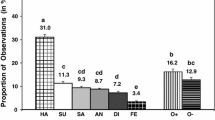Abstract
Adult judges were presented with videotape segments showing an infant displaying facial configurations hypothesized to express discomfort/pain, anger, or sadness according to differential emotions theory (Izard, Dougherty, & Hembree, 1983). The segments also included the infant's nonfacial behavior and aspects of the situational context. Judges rated the segments using a set of emotion terms or a set of activity terms. Results showed that judges perceived the discomfort/pain and anger segments as involving one or more negative emotions not predicted by differential emotions theory. The sadness segments were perceived as involving relatively little emotion overall. Body activity accompanying the discomfort/pain and anger configurations was judged to be more jerky and active than body activity accompanying the sadness configurations. The sadness segments were accompanied by relatively little body movement overall. The results thus fail to conform to the predictions of differential emotions theory but provide information that may contribute to the development of a theory of infant expressive behavior.
Similar content being viewed by others
References
Bridges, K. M. B. (1932). Emotional development in early infancy.Child Development, 3, 324–341.
Camras, L. A. (1991). Conceptualizing early infant affect: View II and Reply. In K. Strongman (Ed.),International review of studies on emotions (pp. 16–28, 33–36). New York: John Wiley & Sons.
Camras, L. A. (1992). Expressive development and basic emotions.Cognition and Emotion 6(3,4), 269–284.
Camras, L. A., Malatesta, C., & Izard, C. (1991). The development of facial expressions in infancy. In R. Feldman & B. Rimé (Eds.),Fundamentals of nonverbal behavior (pp. 73–105). Cambridge: Cambridge University Press.
Dahl, H., & Stengel, B. (1978). A classification of emotion words: A modification and partial test of de Rivera's decision theory of emotions.Psychoanalysis and Contemporary Thought, 1, 261–312.
Davitz, J. (1969).The language of emotion. New York: Academic Press.
Hiatt, S., Campos, J., & Emde, R. (1979). Facial patterning and infant emotional expression: Happiness, surprise, and fear.Child Development, 50, 1020–1035.
Izard, C. (1979).The maximally discriminative facial movement coding system (MAX). Newark, DE: Instructional Resources Center, University of Delaware.
Izard, C., Dougherty, L., & Hembree, E. (1983).A system for identifying affect expressions by holistic judgements (AFFEX). Newark, DE: Instructional Resources Center, University of Delaware.
Izard, C., Hembree, E., & Huebner, R. (1987). Infants' expressions to acute pain: Developmental change and stability of individual differences.Developmental Psychology, 23, 105–113.
Izard, C., & Malatesta, C. (1987). Perspectives on emotional development I: Differential emotions theory of early emotional development. In J. D. Osofsky (Ed.),Handbook of infant development (pp. 494–554). New York: Wiley.
Levenson, R., Ekman, P., & Friesen, W. (1990). Voluntary facial action generates emotion-specific autonomic nervous system activity.Psychophysiology, 27, 363–384.
Malatesta-Magai, C., & Izard, C. (1991). Conceptualizing early infant affect: View I & Reply. In K. Strongman (Ed.),International Review of studies on emotion (pp. 1–15, 29–32). New York: John Wiley and Sons.
Matias, R., & Cohn, J. (1991).Evidence for the differentiation of positive but not negative affect during the first half year. Manuscript submitted for publication.
Ortony, A., Clore, G., & Foss, M. (1987). The referential structure of the affective lexicon.Cognitive Science, 11, 341–364.
Ortony, A., & Turner, T. (1990). What's basic about basic emotions?Psychological Review, 97, 315–331.
Osgood, C., Suci, G., & Tannenbaum, P. (1958).The measurement of meaning. Urbana: University of Illinois Press.
Oster, H., Hegley, D., & Nagel, L. (1988, April).The differentiation of negative affect expressions in infants. Paper presented at the International Conference on Infant Studies, Washington, D.C.
Oster, H., Hegley, D., & Nagel, L. (1992). Adult judgments and fine-grained analysis of infant facial expressions.Developmental Psychology, 28(6), 1115–1131.
Russell, J. (1991). Culture, scripts and children's understanding of emotion. In C. Saarni & P. Harris (Eds.),Children's understanding of emotion (pp. 293–318). Cambridge: Cambridge University Press.
Scherer, K. (1984). On the nature and function of emotion: A component process approach. In K. Scherer & P. Ekman (Eds.),Approaches to emotion (pp. 293–317). Hillsdale, NJ: Erlbaum.
Smith, C., & Ellsworth, P. (1985). Patterns of cognitive appraisal in emotion.Journal of Personality and Social Psychology, 48, 813–838.
Sroufe, L. A. (1979). Socioemotional development. In J. Osofsky (Ed.),Handbook of infant development (pp. 462–516). New York: Wiley.
Werner, H. (1948).Comparative psychology of mental development. New York: International Universities Press.
Author information
Authors and Affiliations
Additional information
This article is based on the second author's master's thesis. The authors thank Dennis Ross for his expert assistance in the data analyses.
Rights and permissions
About this article
Cite this article
Camras, L.A., Sullivan, J. & Michel, G. Do infants express discrete emotions? Adult judgments of facial, vocal, and body actions. J Nonverbal Behav 17, 171–186 (1993). https://doi.org/10.1007/BF00986118
Issue Date:
DOI: https://doi.org/10.1007/BF00986118




